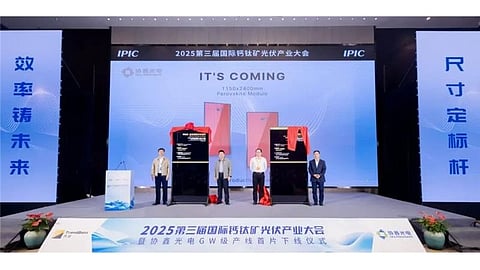

GCL Perovskite, the perovskite manufacturing arm of GCL Group, has produced its first full-size perovskite module at its GW-scale production base. The module measures 2.76 m2 (2,400 × 1,150 mm), which the company claims is the largest mass-produced and commercialized perovskite module globally.
The GW-scale base, located in Kunshan, Jiangsu Province, has a planned capacity of 2 GW, with the first 1 GW phase having entered operation in June 2025.
GCL Perovskite has so far achieved 19.04% efficiency for single-junction perovskite modules and 29.51% for tandem modules in laboratory tests. The company stated that it aims to drive large-scale commercialization through this new facility.
In July, GCL Perovskite completed a Series C2 financing round for nearly RMB 200 million ($27.78 million), to be used, among other things, to advance the industrialization of its GW-scale perovskite production base (see China Solar PV News Snippets).
The China Electricity Council (CEC) released its Q3 2025 Power Supply and Demand Analysis and Forecast Report, revealing that in the first 3 quarters, China added 367 GW of new power generation capacity, including 301 GW from wind and solar, which accounted for 82.2% of total new installations.
CEC forecasts that total new generation capacity will exceed 500 GW in 2025, with grid-connected wind and solar installations surpassing 400 GW.
By the end of 2025, China’s total installed power capacity is expected to reach around 3.9 TW, up 16.5% year-on-year (YoY). Of this, wind and solar power will likely reach 1.8 TW, accounting for about 46.5% of the total, while thermal power will total 1.55 TW, including 1.27 TW of coal-fired capacity.
Manufacturer of inverters and polysilicon and power plant developer TBEA has shipped its first 110 kV offshore PV prefabricated substation for deployment at the Changli Offshore PV Project in Hebei Province. The company stated that this is the industry’s first integrated 110 kV box-type substation, designed to address challenges such as mechanical strength, tilt resistance, and marine environment durability.
The system uses a T-head connection between the Gas-Insulated Switchgear (GIS) and transformer for enhanced integration and features an ultra-high transformation ratio of 110 kV/0.8 kV, enabling direct high-to-low voltage conversion to reduce power loss and system complexity.
TBEA noted that while traditional offshore PV substations operate up to 66 kV, this 110 kV solution significantly improves collection capacity and transmission efficiency, while reducing cable and circuit requirements.
Earlier this month, TBEA announced its plans to acquire a 74.1942% stake in Shuguang Cable through its wholly owned subsidiary (see China Solar PV News Snippets).
Metron New Materials, a leading manufacturer of diamond wires for PV wafer slicing, has reported financial results for Q3 2025. The company’s revenues for the period rose 25.49% YoY to RMB 511.46 million ($71.3 million). However, net profit excluding non-recurring items plunged 789.26% to RMB 61.58 million ($8.6 million).
For the 9M 2025, Metron recorded revenues of RMB 1.52 billion ($211.7 million), down 19.7% YoY, and a net profit (excluding non-recurring items) of RMB 120.89 million ($16.9 million), representing a 51% decline from the same period last year.
